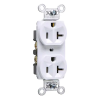- Jun 13, 2000
- 26,392
- 1,780
- 126
I have a 2014 clothes washer that's wired off a 15amp circuit with 12/2 and the quality Cooper receptacles. I normally would use a wire nut and pigtail, but didn't on this circuit. I just had the circuit go through the receptacles point to point and then have the washer circuit coming off one of them. The circuit has been in service now for maybe 3 years.
The motor for wash and spin cycles must have heated up the connection enough...maybe it was loose and arcing inside the receptacle....but it ended up melting the point where the hot wire connects to the washer receptacle. We never smelled burning smells before, so this apparently is a very recent issue. In the past few days, it's burned the hot side of the plug and I cut off a solid inch and a half of 12 gauge wire because the insulation was brittle/burned from the heat. (only the wire feeding the washer).
The hexagon is the breaker....the 4 diamond shapes are the receptacles....and the box is the washer. The diamond shape in the middle is the receptacle that melted, not the one next to the washer.

I installed a new receptacle, but am wondering now if I need to go back and make these connections a little more robust. (maybe even soldering the wires together instead of wire nuts)
I have these push on connectors as well wire nuts, but not sure how they would handle this load.

If the receptacles were lower grade, I would expect failures, but perhaps the connection was just loose and it would have happened anyway.
Anyone have experience with this kind of thing?
The motor for wash and spin cycles must have heated up the connection enough...maybe it was loose and arcing inside the receptacle....but it ended up melting the point where the hot wire connects to the washer receptacle. We never smelled burning smells before, so this apparently is a very recent issue. In the past few days, it's burned the hot side of the plug and I cut off a solid inch and a half of 12 gauge wire because the insulation was brittle/burned from the heat. (only the wire feeding the washer).
The hexagon is the breaker....the 4 diamond shapes are the receptacles....and the box is the washer. The diamond shape in the middle is the receptacle that melted, not the one next to the washer.

I installed a new receptacle, but am wondering now if I need to go back and make these connections a little more robust. (maybe even soldering the wires together instead of wire nuts)
I have these push on connectors as well wire nuts, but not sure how they would handle this load.

If the receptacles were lower grade, I would expect failures, but perhaps the connection was just loose and it would have happened anyway.
Anyone have experience with this kind of thing?



